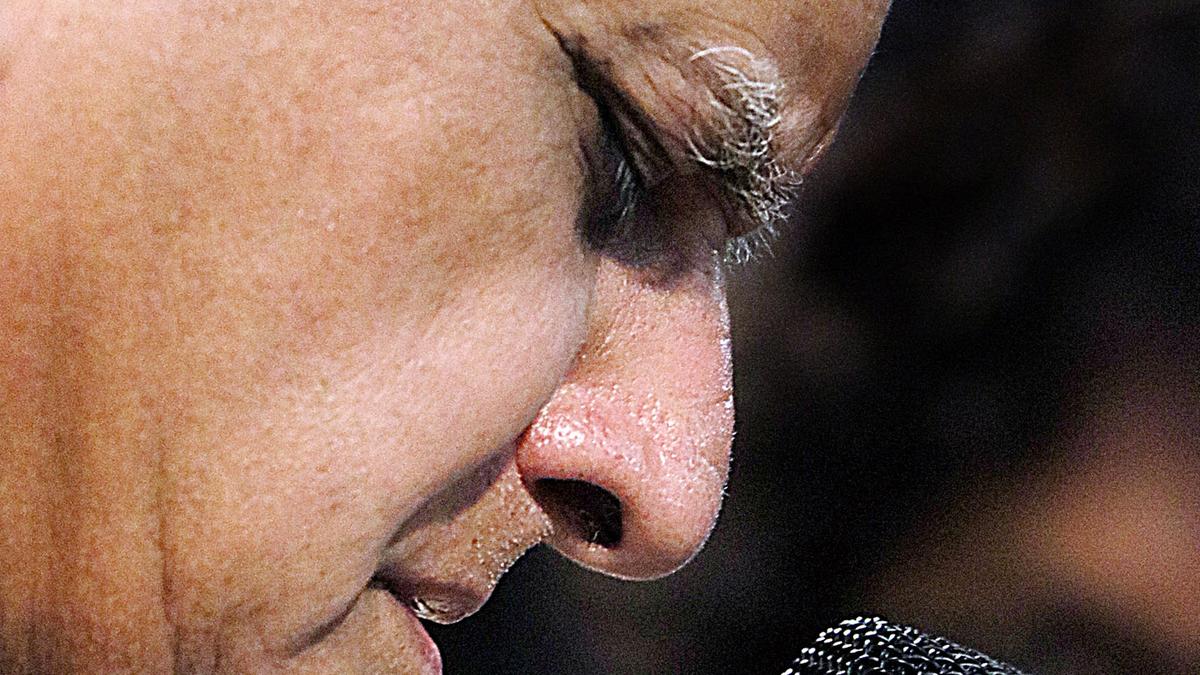Renowned vocalist Pt. Ulhas Kashalkar
| Photo Credit: Special Arrangement
It was the concluding nightlong session of the 102nd Sankat Mochan Sangeet Samaroh in Varanasi, and the courtyard of the Sankat Mochan temple saw a constant flow of devotees. Would a classical soiree work in this busy, crowded environment, one thought. But Pt. Ulhas Kashalkar, a deeply spiritual person, seemed unperturbed as he hummed a few swars to check the mic. He gave a brief but sharp glimpse of his choice with a hint of komal nishad and moved on to sing the slow Tilwada bandish with key-phrases based on the portrayal of Kedar, the abode of Shiva. The cajoling passages of behlawa, beautifully highlighted by Pt. Suresh Talwalkar’s tabla was enough to draw the attention of even lay listeners. ‘Kanha re, Nand-nandana’, the popular chhota khayal, followed by a tarana, cast its spell.
Before Ulhas Kashalkar could move on to close the recital with a bhajan, there were requests for a jod raag. Rightly so, because the vocalist does magic with Jod/Mishra/Sankeerna raags in which two or more raags move simultaneously. For example, Saanjh Swaravali (Saraoli), invented by Ustad Vilayat Khan, and premiered presented in Ulhas Kashalkar’s voice, displayed almost all major raags of the evening. This makes it a Sankeerna (narrow) raag. The paucity of space sometimes results in the raags getting mangled if treated by an artiste lacking expertise. But, Ulhas Kashalkar made them appear like an aesthetically arranged bouquet of multi-hued flowers.
Malkauns-Bahar came as a dual-coloured gift for his admirers — the lower half of the octave was dominated by Malkauns and the upper half by Bahar. There was no confusion, the transition was smooth. Malkauns is ponderous, powerful and regal while Bahar is restive, playful and light- hearted. But, like a well-adjusted couple, they existed together despite their diagonally opposite characters.
Ulhas Kashalkar performing at the 2025 edition of the Sankat Mochan Sangeet Samaroh
| Photo Credit:
Special Arrangement
Speaking after the concert about his method and approach when pairing raags that are poles apart, Ulhas Kashalkar said: “The only method is familiarity with raags. We often talk about fusion, but very few pay heed to the requisites prior to trying out such exercises. I often sing Malkauns and Bahar in concerts. As individual raags, both have strong characters, yet together, they guide me to equally beautiful new ways. Getting familiar with the total structures of raags, along with their resting places, junctions and turning points, help open the fountainhead of a new challenging melody. In this case, the magical note was Madhyam, an important junction for both raags.”
As someone who is a master of the Gwalior, Jaipur and Agra gharanas, each of which has its set of favourite raags, taals and compositions, does Ulhas Kashalkar mix gharana specialties for a thrilling innovation? “I am a traditionalist. Gwalior excels in Alhaiya Bilawal, Hameer, Gaud Sarang, Chhayanat, Kedar, Kamod and Yaman and Bhairav. Jaipur specialises in Patmanjari, Khat, Sawani, Shuddh Nat, Nat ke Prakar and Anandi. This gharana is known for its ‘Anwat’ and Jod-raag preferences. Agra has a fondness for Dhanashri, Barwa, Jaijaiwanti, Nat Bihag and Lalita Gauri. It is not advisable to interchange the raags or their bandishes as all these styles have different approaches, taal-lay preferences and set patterns for embellished gayaki. The sanctity of each gharana should be guarded.”
So, how does Ulhas Kashalkar define the sanctity of raags and gayakis?
“Purity is what the Gurus gave us. Gharana characteristics help immensely in the process of learning. The gharana lays the foundation; the rest can be added according to one’s capability or limitation. For example, in Kirana gharana, the singing styles of Gangubai Hangal and Bhimsen Joshi are very different. Ustad Amir Khan added so much of his individual flourishes that his style became a different gharana! Gwalior seems to have experimented the most. We find such individualistic stamps of legends such as Omkarnath Thakur, Kumar Gandharva and DV Paluskar, among others.
“When I began my singing career, I sang the Gawlior, Jaipur and Agra gharanas the way I was taught. But, with time and maturity, I incorporated many changes in my own distinct way, and this brought all the three styles closer,” said the renowned vocalist.
Published – May 06, 2025 05:47 pm IST
